Be best dressed for trade dress registration in Australia
Trade dress is a broad term to describe distinctive elements that are used in isolation or combination to function as an indicator of the source of the goods or services.
What is trade dress?
Trade dress is a broad term to describe distinctive elements that are used in isolation or combination to function as an indicator of the source of the goods or services. In some cases trade dress may be a single element such as a colour, shape or packaging of a product. In other cases trade dress may be an arrangement of elements and, for example, may incorporate word marks, logos, packaging, signage, and websites. Put simply, trade dress is the overall “image” of a product or service.
If the trade dress serves to distinguish the source of a product or service from those of its competitors, one or more elements that make up the trade dress may satisfy the requirements for registration as a trade mark.
Registration trends for trade dress marks at IP Australia (IPA)
There are types of trade dress which have been registerable for many years, including the distinctive shapes of perfume and liqueur bottles, unusual shapes for confectionary and biscuits, the stitching patterns for clothing, and the chevron shapes and tread patterns for shoes.
Evolving practice at IPA has moved the line between what is considered functional or decorative elements as opposed to arbitrary and fanciful elements of trade dress marks. This is in response to changes in how consumers view trade dress elements as an identifier for the source of products and services, and how traders use, protect and educate their customers to recognise their trade dress. Owners have become more innovative in their branding, and seek protection for different aspects of trade dress. Therefore IPA has overlaid the registrability tests for traditional trademarks onto trade dress marks.
Looking back more than a decade:
- the colour GREEN for BP’s petrol station trade dress was refused as the court was not convinced that BP’s green trade dress for cladding, signage and pumps was sufficiently arbitrary nor sufficiently distinctive through use: Woolworths Limited v BP plc [2006] FCAFC 132
- Cadbury sought to register its colour PURPLE trade dress for chocolate generally. Cadbury was able to convince the registrar and the court that the trade dress was distinctive only for block and boxed chocolate: Cadbury Schweppes Pty Ltd v Darrell Lea Chocolate Shops Pty Ltd [2009] FCAFC 8
- the seahorse and shell shapes for Guylian chocolates were held to be unregistrable due to non-distinctiveness: Chocolaterie Guylian N.V. v Registrar of Trade Marks [2009] FCA 891.
More recently Ferrero Rocher has obtained registration for the get-up of its confectionery egg; Danoz has registered the surface coating for various kitchen items; Lindt has registered its chocolate bear shaped confectionery and Bega has registered the packaging for vegemite. Exxon Mobile obtained registration of its service station trade dress, and Tiffany registered its BLUE colour and packaging for retail services for jewellery.
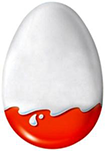
| Colours claimed: WHITE and RED-ORANGE. |

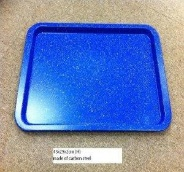 | The trade mark is a colour trade mark and consists of the colours SAPPHIRE variegated with SILVER specks as shown in the representations attached to the application form, applied to the surface of the goods for which registration is sought. |

| The trade mark consists of a three dimensional shape of a teddy bear wrapped in gold foil, with a red ribbon and heart-shaped pendant round the neck, as shown in the representations attached to the application form. |
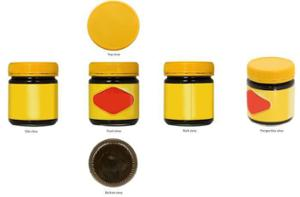
| The trade mark consists of the shape of a jar and lid, with the jar bearing a yellow-coloured label including a red-coloured logo, the lid being yellow-coloured and the jar having a contrasting brown colour, as shown in the representation(s) attached to the application form. |

| The trade mark consists of the word "MOBIL" in the colours red and blue in combination with the colours red, blue, grey and white applied to the exterior surfaces of a canopy, signs, poles, fittings and bowsers as shown in the representation attached to the application form. The features shown in broken lines, the words "FUEL TECHNOLOGY", the word "SYNERGY" and the circular device appearing next to and beside the word "SYNERGY" appearing in the representation do not form part of the mark. |
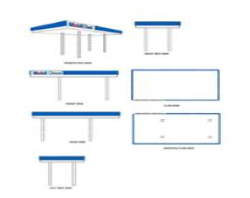
| The trade mark consists of the shape and appearance of a canopy bearing the words 'Mobil' and 'Diesel', in the colours RED, WHITE and BLUE as depicted in the representation attached to the application form. |

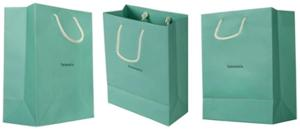  | The mark consists of the colour BLUE with RGB Profile R117 G210 B204, as shown on the form of the application, applied to the whole visible surface, or being the predominant colour applied to the visible surface of the packaging of the goods or in relation to the supply of services covered by the registration. |
Not all trade dress marks are created equal
With so much effort driving the creation of trade dress branding it is not surprising that owners wish to protect the trade dress of their products and services. To gain registration of trade dress in Australia, the first hurdle is to convince the registrar that the elements being claimed function as a trade mark to create recognition of the source of the products or services in customer's minds, and are not seen as merely functional or decorative. That is, the trade dress must be adapted to distinguish or have the capacity to distinguish one traders’ goods and services from those of another. Alternatively the trade dress must have acquired distinctiveness as an indicator of source as a result of use and reputation.
For example, fluro yellow colour has a visibility function, which would not be adapted to distinguish work clothing. It should be registrable for other clothing such as sleepwear, although evidence of use may be required to demonstrate capacity to distinguish, given IPA’s reluctance to register single colours. Lime flavoured beverages are sold commonly in green cans, and this colour is not adapted to distinguish for these goods. In contrast, the overall silver/blue/red trade dress of the Red Bull beverage can is arbitrary and registerable.
The Australian Trade Marks Act defines a trade mark as “a sign” which includes any of the following: letter, word, name, signature, numeral, device, brand, heading, label, ticket, aspect of packaging, shape, colour, sound, scent, or any combination of these. The non-traditional signs include aspects of packaging, shape, colour, sound, and scent. The non-traditional signs were introduced with the Australian Trade Marks Act 1995 and since then, the registration of some non-traditional marks, such as shapes of bottles, tablets, toys and containers, has progressed relatively easily. However there is 'tension' when it comes to protection of marks which include other trade dress components. While the boundaries of what constitutes a trade mark are expanding all the time, registration practices can take some time to catch up.
How to show capacity to distinguish or acquired distinctiveness
The test to assess registrability of trade dress marks is the same as for other types of marks. The examiner must determine if the mark has any inherent capacity to distinguish and if the answer is yes, if evidence of use is needed to demonstrate the mark is likely to be capable of distinguishing or has already acquired distinctiveness. The aim of evidence is to satisfy the examiner that there is a likelihood that for consumers the primary significance of the trade dress is to identify the source of the product.
Tips for preparing for trade dress registration
If trade dress is to be protected, it is prudent to be prepared to put forward the best case. Keeping the following in mind could make the process easier:
- Trade dress is often a combination of distinctive and non-distinctive elements. The aim is to create trade dress that has a high proportion of distinctive elements.
- Before commencing use, consider whether a registered design would provide valuable protection in addition to trade mark registration. There is no prohibition to registering a 3-D article or an aspect of packaging under the Designs Act as well as a trade mark under the Trade Marks Act.
- Be consistent in use of the trade dress, as the examiner will look for consistency to assess if customer familiarity is likely, and the use will be recognised as an indicator of source.
- For some trade dress applications, for example single colours applied to less distinctive packaging shapes, it is likely that evidence of use over a period of more than five years will be needed to demonstrate acquired distinctiveness
- Proactively educate customers by reference to the trade dress in advertising or promotion by identifying the trade dress features as a trade mark rather than a decorative or functional element.
- Maintain watches, and object to copying and imitation by competitors. These measures will help retain exclusivity and to prevent the trade dress elements becoming common and generic.
- Seek to register trade dress at the earliest opportunity. This will not only afford protection against imitators, but also provides a deterrent, as simply having the trade mark application or registration on the public register serves as a notice of the claim to trade mark rights.
The final tip is to plan ahead at the time of creation of the trade dress and while it is being used. This will become valuable when you are ready to seek protection.